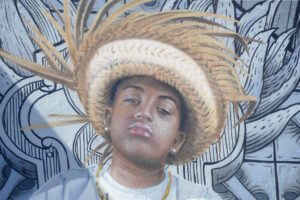A couple of weeks ago, I introduced the 25 best things to do on a weekend trip to Frankfurt am Main, mostly known as Germany’s financial power station. One of the activities I recommended was getting to know the best street art in Frankfurt. Because not only is the city home to some of Germany’s best art museums. It is also a cradle of some of the most amazing urban artists such as Case MaClaim and Hera from the artist duo Herakut. In this post, I’m introducing you to some of Frankfurt’s best urban artists.
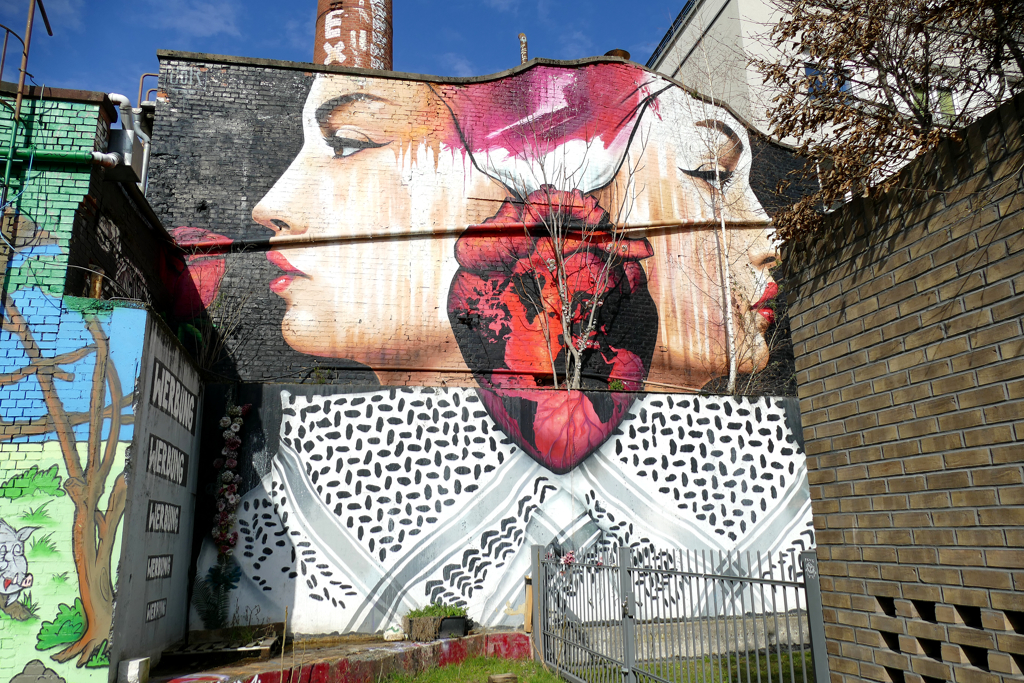
The Problem With Frankfurt
Frankfurt on the River Main is one of Germany’s most misconceived cities. Just for the record: I’m emphasizing the exact location since there is another Frankfurt in Germany bordering Poland. Frankfurt on the Main, however, is mainly recognized as Germany’s financial hub, hence, economically relevant but otherwise absolutely neglectable.

Also, the area around the main train station is infamous for being some kind of German Skid Row. And indeed, it is very unpleasant, to say the least. But nobody forces you to go there. Just two blocks south are the idyllic banks of the river Main with a long row of some of Germany’s best museums.

As a matter of fact, Frankfurt has 60 museums that host some of the best exhibitions in all of Europe. Why is nobody talking about that?
In the Streets Of Frankfurt
In addition to some world-famous art hanging around in Frankfurt’s art museums, there is also an amazing number of urban art in squares’n’streets of the city. And this is by no means a coincidence. For the governmental Cultural Office Frankfurt am Main, art in public spaces is a mission including amazing opportunities. Regarding urban and social development, it is worth focusing on urban art more than ever.
Hence, the range of around 550 objects that can be seen in Frankfurt’s public spaces is outstanding: Historicist bronze statues, hyper-modern sculptures, huge light installations, and street art such as graffiti and murals are found all around the city.
Since 2014, a designated Art in Public Space Department of the aforementioned Cultural Office has been promoting the participation of Frankfurt-based artists. Also, on their website, the office publishes a comprehensive database including information on more than 500 objects and their creators. Yes, including street artists.
Street Art in Frankfurt
In Frankfurt, just like in other European cities, contemporary street art began with graffiti by punks and later by hip-hoppers in the 1980s. In the beginning, graffiti was primarily about acceptance in the respective peer group. The fact that it was illegal to paint on public walls and dangerous to spray on trains only added to the myth’n’hype.

But gone are the days when graffiti as a whole was considered vandalism. Over the years, it became an important part of contemporary art, and artists in baseball caps and sneakers are making good money with their skills.

Yet, graffiti remained the art form of a particular crowd and still follows its own rules. Graffiti still tends to be an artistic way to express protest and trigger social and political issues.
In Frankfurt, you’ll spot artistic murals as well as quirky and provocative paintings. However, oftentimes, you’ll need to venture from the very center to the outskirts.
The Artists
Most of the time, when I write about urban art, I’m introducing one or two outstanding cultural or social projects: In Málaga, it was MAUS, in Amsterdam If Walls Could Speak, in Copenhagen the Open Air Gable Gallery, and in Paris Street Art 13, to name just a few. The advantage is that the murals are then bunched within a particular perimeter.
In Frankfurt, this is not the case. To put together this post, I had to travel crisscross the city. And since the Rhine-Main area consists also of towns like Bad Vilbel, Mainz, and Wiesbaden, you’d have to travel quite a bit to see some of the wonderful artworks.
Hence, I restricted myself to the very city limits. Also, I’m not introducing Frankfurt’s street art by area, but by artist in alphabetic order. However, in the map below, you can trace where exactly the particular murals are located.
As always, I’ve added a list of the Instagram accounts of all artists featured in this post. This way, you can enjoy more of their work straight from your lazy chair.
Andy and Chris Kaminsky aka ACK2
Andy and Chris Kaminsky aka ACK2 were commissioned to paint a façade facing Merianplatz in 2011.

On 15 meter high building, they adjusted a half-open zipper. Then, above the zipper at the highest point of the façade, they portrayed an old lady looking out of a window.
Justus Becker aka COR
Justus Becker who goes by the nom de plume spray can COR as a memento of his major heart surgery.
In his early years, COR was spraying illegally and was even arrested a couple of times. Despite these tribulations, he became one of the best sprayers in the area. During his studies of Illustration and Fine Arts, COR embellished walls mainly around Frankfurt, but also in Berlin, Guangzhou, Hamburg, New York, Toronto, and other countries around the world.

As social topics matter to COR and are a vital part of his artistic work. He is involved in various social projects both artistically as well as financially.
Also, major companies commission his pieces that often incorporate expressive photo-realistic portraits.
Murals at the Naxos Plant
The cover picture of this post shows a powerful portrait created by COR. You’ll find it at the so-called Naxoshalle. This site is a former factory building of the Naxos Union company. It was completed in 1907 in the Ostend district near the Frankfurt Zoo. Production of abrasives in the plant was abandoned and relocated to another site at the end of the 1980s.

The building was on the brink of falling into disrepair when entrepreneur Josef Buchmann bought the property and rented it out to the city of Frankfurt in 1989. Today, it houses a theater, and municipal institutions catering to children and indigent families.

Also, they are used for cultural events and as concrete canvasses by graffiti sprayers. Hence, venturing into this area outside the very city center is definitely worth it.
Case MaClaim
Andreas von Chrzanowski, far better known as Case MaClaim, was born in 1979. He is a founding member of the muralist group MaClaim, which came together in 2000. The crew is mainly known for amazing photorealistic works, and Case specializes in hands as well as other parts of the human body.

In Frankfurt, where he currently resides, you’ll find a handful – pun intended – of his best pieces like for instance the large-scale twin portrait on Miquelallee. On one wall, a woman is writing on a typewriter, and one block down, a man is reading her letter.

Another very cool piece is found on the back of the small house on Hanauer Landstraße right next to the Ostbahnhof train station. Case MaClaim portrayed the Irish Bishop Patrick on the pub’s façade in cooperation with fellow muralist Mario Laugell aka Klark Kent, in 2014.

Case has left an excellent mark in many cities, and I have already introduced him in my posts on Street Art in Amsterdam, Berlin, and Rabat.
Thomas Stolz
Thomas Stolz has a completely different approach to designing façades. He is less driven by personal artistic development than by color and motif as essential parts of architecture and of construction. In this spirit, Thomas Stolz is enthusiastic about designing color concepts and motifs that give settlements a special atmosphere, making living spaces a real home in the hustle and bustle of cities.

In his unmistakable style, Stolz has created several larger-than-life portraits of great poets and thinkers in the Rhine-Main area: In the Schwanheim district, he honors the Frankfurt social politician and women’s rights activist Henriette Fürth, in Niederursel, the likeness of the playwright Gerhart Hauptmann is emblazoned, and in the district of Nordend the mathematician and physicist Carl-Friedrich Gauß looks down on the Gaußstrasse named after him.
Mathias Weinfurter
In 2014, students from the visual communication department and the NGO Frankfurt Fan Project installed a clear message of tolerance and against discrimination near the Niederrad S-Bahn station. It is a larger-than-life portrait of former professional soccer player Anthony Yeboah. Coming originally from Ghana, Yeboah was often a victim of racism and xenophobia in the Bundesliga. In an open letter, Yeboah, together with Anthony Baffoe and Souleyman Sané, wrote: We are ashamed of everyone who shouts against us.
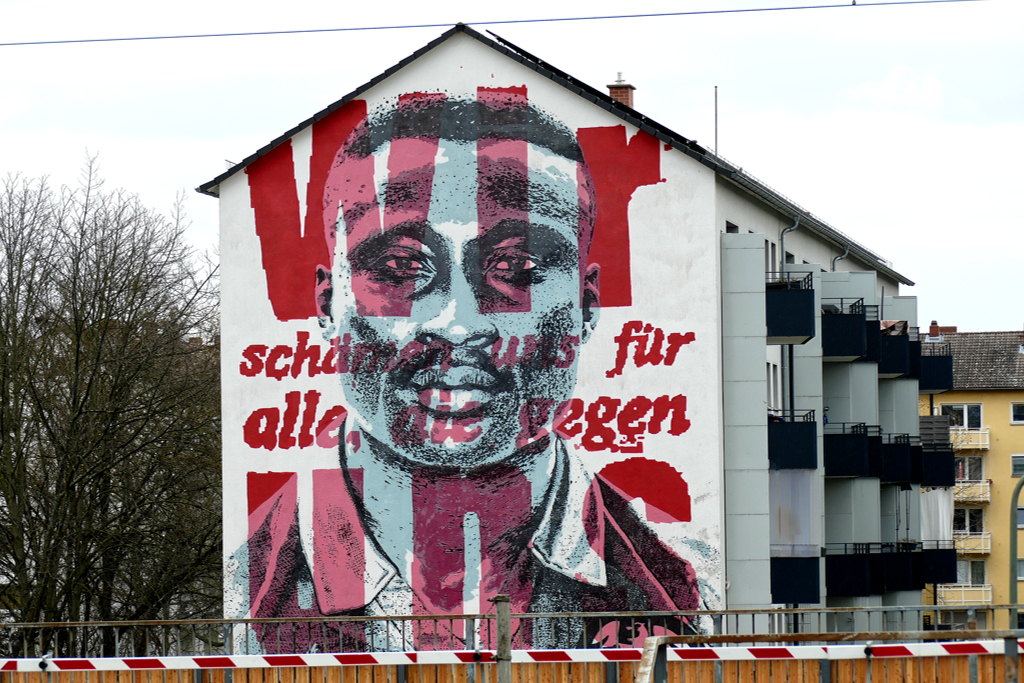
24 years later, the Frankfurt Fan Project started an initiative against racism and xenophobia, i.a. by founding the Keep in Mind Award. Frankfurt-born artist Mathias Weinfurter won the award for his idea of what is now a powerful mural. It is now on the façade of a residential building at Melibocusstraße around the corner from the Niederrad S-Bahn station. Actually, it can be best seen from the local train going to the airport.
Guido Zimmermann
Guido Zimmermann was born in Frankfurt in 1978. He studied art – according to his self-proclamation not at an academy, but in the streets of Frankfurt. From the beginning on, he had a very distinctive, artistic style of delicate shades and soft lines. At that time, this was rather atypical for street art.
Nevertheless, a decade later, Zimmermann graduated from the Academy of Visual Arts in Frankfurt and has worked as a freelance artist ever since.
After having spent some time in London, he’s now back in Frankfurt.
Painting the City
In 2015, Guido Zimmermann initiated the Museum on the Street project through a crowdfunding campaign. The funds he gained were actually sufficient for at least three house façades.

He completed the first piece in 2016. The humongous mural depicts a rodeo: A cowboy jumps off his horse onto a cow and pushes it to the ground.
The second mural realized by means of the crowdfunding campaign was the mural Bull Versus Bear in the Nordend district. Actually, it is the perfect motif in one of Europe’s most significant financial centers.

The bull and the bear are two animals that are also associated with the stock market. The bear is skeptical, holding his funds back due to pessimism and mistrust. In contrast, the bull is optimistic, buying in the hope of an upturn.
In 2021, the Deutsche Bahn, Germany’s national train company, commissioned Zimmermann to decorate the walls, stairways, and waiting areas of Frankfurt’s S-Bahn station Niederrad.

According to the title From Laundry Village to Office Town, Zimmermann painted scenes from the district in the south of the city on an area of 750 square meters.
Leunabunker
The so-called Leunabunker is a former air raid shelter for the employees of the infamous company IG Farben which was built in the 1930s. Already in 1975, musicians used the bunker for their rehearsals for the first time.

The Leunabunker was entirely covered in high-class graffiti in 2010. Today, there are 47 rehearsal rooms that were refurbished by the tenants with their own funds. Around 80 bands and various visual artists are currently working behind the two-meter-thick walls.
Below, I’ve listed the artists that have contributed to the metamorphosis of the bunker into an open-air gallery.
Dingo Babusch
Dingo Babusch was born near Stuttgart. From 1994 to 1997, he completed professional training as a sign maker. With his paintings, he participated in exhibitions in Copenhagen, Milan, Munich, New York, and Vienna, among others. In 2011, he received an Interior Design Award.

Babusch resided in New York in 2006. Apart from pursuing his painting career, he also was a guest speaker at a school in Brooklyn.
Back in Stuttgart, Babusch works on his own artistic projects and organizes workshops. Also, he published the book Sprüher im Rudel, which translates to Sprayers in a Pack in English, in 2005. It’s a documentation of graffiti writing in Stuttgart.
Helge Steinmann aka BOMBER
In Frankfurt, Helge Steinmann aka BOMBER is an urban art legend. Having been a street artist since 1988, BOMBER succeeded in transforming his art into a business. He began creating commissioned graffiti as a freelancer in the early 1990s.

Eventually, he founded what has been allegedly the world’s first agency that arranges jobs for street artists. Also, together with fellow-sprayer CANTWO, he created the first professionally usable color for street artists.

Hendrik Beikirch aka ECB
German graffiti and street artist Hendrik Beikirch was born in Kassel in 1974 and studied art education at the University of Koblenz-Landau. Although he has been an important figure in the graffiti and street art scene since the 1990s, I discovered him only recently in Morocco, of all places, where I was just blown away by his larger-than-life portraits in Marrakech and Rabat.
Beikirch, who also signs his works with the abbreviation ECB, is famous for his hyper-realistic portraits in black and white that he paints on canvas, paper, and walls, obviously. He has a very distinctive artistic language. No wonder his amazing portraits can be found in many places around the globe.
I’ve introduced some of Hendrik Beikirch’s absolutely amazing portraits in my post on JIDAR Street Art Festival – How Rabat Celebrates International Urban Art.
Mick La Rock
Aileen Esther Middel, better known as Mick La Rock, was born in Groningen in 1970. She is one of Europe’s first and most famous female graffiti artists. Inspired by the classic graffiti lettering, she started writing her name MICKEY in 1983. After she had participated in the famous exhibition Coming from The Subway at the Groninger Museum in the early 1990s, well-established street artists invited her to New York. Henceforth, she spent the 1990s between Amsterdam and New York.
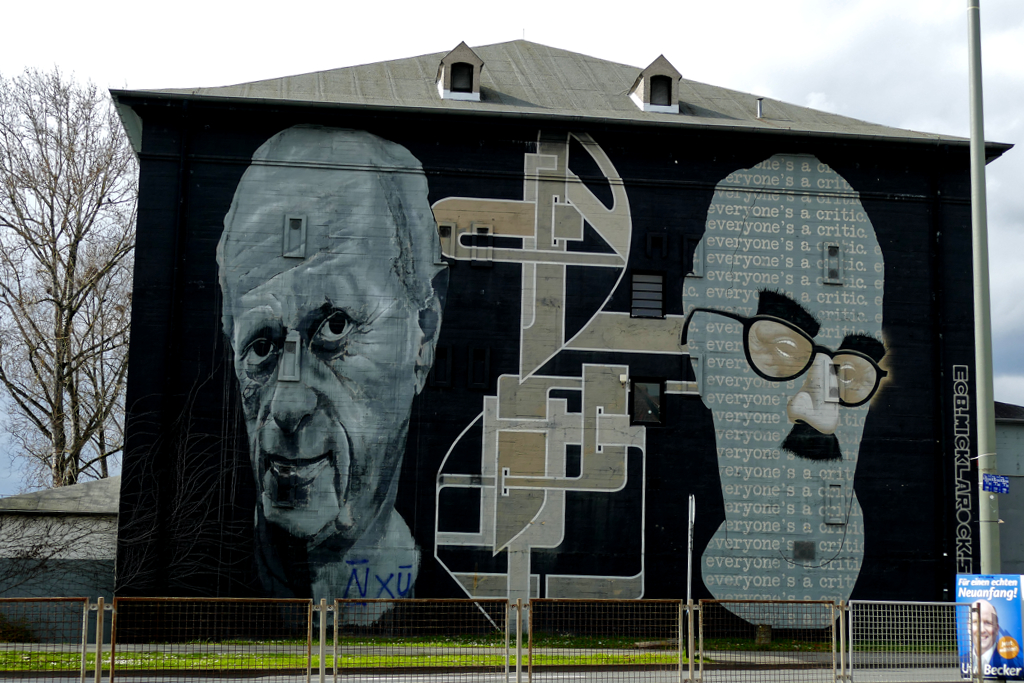
Today, Mick La Rock is a member of the City Curatorial of the Municipality of Amsterdam and paints and curates exhibitions for the city’s world-famous art museums. You can immediately identify her minimalistic work as it’s strongly influenced by brutalist architecture and abstract art of the early 20th century like Dadaism and surrealism.
Mick La Rock currently lives and works in Amsterdam. She is a member of various graffiti crews, and her work has been featured in various publications on graffiti.
SHOK-1
In a unique mix of street art and science, British artist SHOK-1 spray paints unique X-ray art on walls around the world. Enigmatic and full of intricate detail, X-rays are actually a very difficult motif to paint, and SHOK-1 is creating his pieces freehand without any rendering with tape or stencils.

Back in the 1980s, SHOK-1 was one of the first European street artists that sprayers from the US co-opted. Since then, he has continuously reinvented his work during the past 40 years.
SHOK-1 is based in London and holds a degree in Applied Chemistry.
On Instagram
To dig deeper into the subject and see more of the amazing art the above-featured artists have created, you can just check out their Instagram accounts:
ACK2
Dingo Babusch
Hendrik Beikirch aka ECB
Helge Steinmann aka BOMBER
COR
Klark Kent
Mick La Rock
Case MaClaim
SHOK-1
Thomas Stolz
Guido Zimmermann
How to Get Around
Public Transport
As I pointed out above, there is not some kind of cradle of street art in Frankfurt. The individual pieces are, in general, quite far from one another. Therefore, I’m afraid that when you’re looking for street art, you can’t avoid using public transport. However, like in every other German city, local public transport in Frankfurt is comprehensive, too. There are buses, trams, subways, and local as well as regional trains.

A regular ticket for the city costs 3.40 €uros and is valid throughout the city with the exception of the airport. There are short-distance tickets for 2.10 €uros. You have to check at the bus stations or the ticket machines whether those tickets apply.
Since tickets don’t have to be validated, single tickets have to be bought right before boarding.
If you don’t have a Frankfurt Card*, a 58 €uros ticket, or any other discounted pass, the best deal for you will be an all-day ticket for 6.65 €uros. Parties of up to five people pay 12.60 €uros for an all-day group ticket. Both tickets are good for an unlimited number of trips.
Cycling
Another way to explore at least the murals in Frankfurt’s center is by bicycle. The company that rents out bikes is called Call a Bike, and you can find their website here. Registration is free.
As one of the largest bike-sharing networks in Germany, Call a Bike offers you quick access to more than 13,000 bicycles not only in Frankfurt, but also in Berlin, Hamburg, Cologne, and Munich, to name just a few of the more than 80 municipalities.
Download the Call a Bike app Download and register with your email, mobile phone number, and credit card. Then you can choose a bike on a map or with a QR code. The lock will open automatically. If you need a break, you simply click on the Pause button and push down the lock lever on your bike. To travel on, go to Continue in your booking, and the lock opens. Nevertheless, keep in mind that the clock keeps ticking also during your break.
As you return the bike to a station and close the lock, your journey is over.
There are neither free minutes nor is there a flat rate. You’ll be charged 1 €uro for 15 minutes up to a maximum of 9 €uros per day.
Also, you can always ask your hotel if they have rental bikes for their customers. This might be a less complicated option, however, they probably won’t be cheaper.
Map
This map should help you find the murals I’m introducing in this post. Clicking on the slider symbol at the top left or the full-screen icon at the top right will display the whole map, including the legend.
Amazing Street Art was only one kind of art I got to see on my visit to Frankfurt. To read about the rest, go to this comprehensive guide where you’ll find further valuable information that will make your own trip much smoother and more enjoyable. If you have only a short layover in the city, my post 24 hours in Frankfurt has you covered.
Pinnable Pictures
If you choose to pin this post for later, please use one of these pictures:





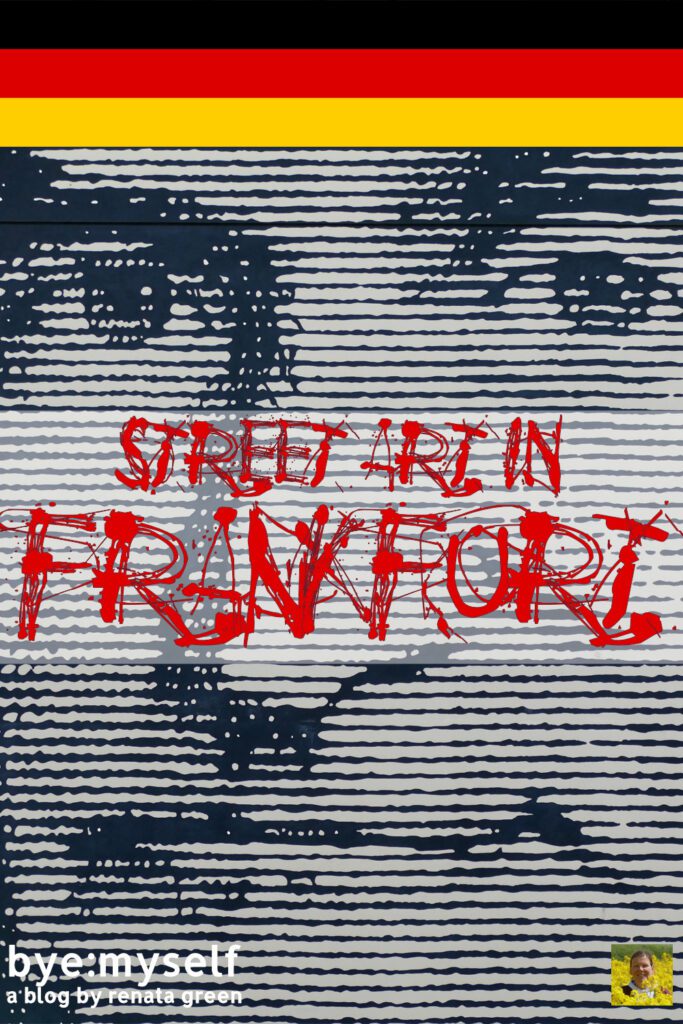
Did You Enjoy This Post? Then You Might Like Also These:
MAGNIFICENT MARTINIQUE: Ten Places Not to Miss on Your Visit (even when exploring by public bus)
ARUBA: The Powerful Murals of San Nicolas
Best Street Art in BRUSSELS
The Best and Most Beautiful Beaches of Naxos
Best Street Art in BERLIN
Best Street Art in VALENCIA
BORDEAUX: Best Street Art on the Right Bank of the Garonne
Best Street Art in RIGA
* This is an affiliate link. Hence, If you book through this page, not only do you get the best deal. I also get a small commission that helps me run this blog. Thank you so much for supporting me!

